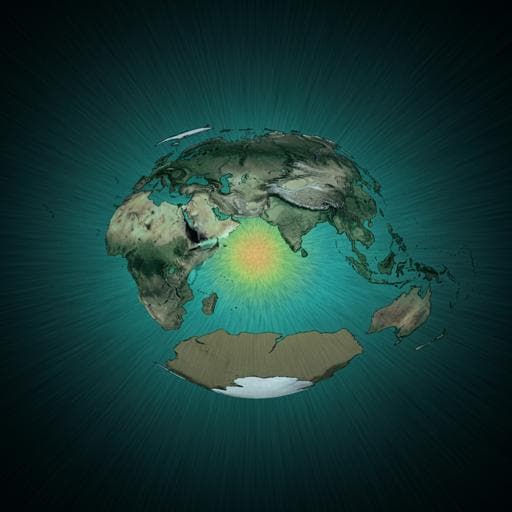
Earth Sciences
An emerging Asian aerosol dipole pattern reshapes the Asian summer monsoon and exacerbates northern hemisphere warming
B. Xiang, S. Xie, et al.
Explore the intriguing dynamics of the Asian aerosol dipole pattern, as recent research reveals its significant climate impacts. Conducted by Baoqiang Xiang, Shang-Ping Xie, Sarah M. Kang, and Ryan J. Kramer, this study uncovers how aerosol changes in South and East Asia influence summer precipitation and northern hemisphere warming, with vital implications for our understanding of global climate.
~3 min • Beginner • English
Introduction
Anthropogenic aerosols (AAs) influence regional and global climate via radiative effects and cloud interactions but remain challenging to simulate due to complex composition, spatial variability, and aerosol–cloud processes. Since the 1980s, emissions have shifted from the western to the eastern hemisphere, with declines over North America and Europe and increases over South Asia (SA) and East Asia (EA). Around the early 2010s, observations show a marked Asian aerosol dipole (AAD): continued aerosol increases in SA and substantial reductions in EA driven by emission controls in China. These changes are reflected in top-of-atmosphere shortwave instantaneous radiative forcing (SW IRF) trends: negative over SA and positive over EA. The central research question is how this emerging AAD pattern affects climate, particularly the Asian summer monsoon and hemispheric temperature patterns, and why forcings in SA versus EA produce different global responses. Understanding these impacts is societally important due to implications for precipitation, extreme events, and decadal climate prediction affecting billions across Asia and beyond.
Literature Review
Prior studies have documented aerosol impacts on monsoon rainfall, extremes, and large-scale circulation. Increasing aerosols have been linked to weakened South Asian monsoon precipitation since mid-20th century and to changes in extratropical circulation (e.g., Eurasian jet) and tropical cyclone activity distributions. Aerosol-induced radiative forcing can shift the ITCZ and modulate Hadley circulation; regional aerosol forcing can generate divergent global-scale temperature responses depending on location. CMIP6 models struggle to capture recent observed AAD patterns due to emission dataset issues, complicating direct multi-model assessment. Literature also highlights that reductions in aerosols can enhance monsoon precipitation in future projections, and that circumglobal teleconnections (CGT) can be triggered or modulated by monsoon variability and external forcings. This study builds on these findings by isolating SA vs EA aerosol pattern effects using idealized experiments and observations-based SW IRF scaling.
Methodology
Models and experiments: A developmental version of GFDL AM4 (atmosphere) coupled to the FLOR ocean model (~1° resolution) is used, with external forcings fixed at year-2000 levels. Interactive aerosols are turned off; climatological aerosols are prescribed to isolate direct aerosol radiative effects. A 150-year control simulation provides baseline states.
Idealized forcing design: Two coupled sensitivity experiments impose regional radiative perturbations by proportionally adjusting the solar constant over defined domains to mimic dominant nonabsorbing (sulfate-like) scattering aerosol changes: SA (65°E–91°E, 7°N–29°N) and EA (103°E–129°E, 11°N–43°N). Each experiment comprises six ensemble members integrated 50 years; analysis uses ensemble means over the last 30 years. A two-sided t-test assesses significance at 5%.
AMIP-type simulations: Corresponding atmosphere-only (AMIP) runs with prescribed climatological SST and sea ice from the coupled control are conducted (50 years each). Effective SW radiative forcing over the domains is quantified from AMIP, yielding nearly identical total power (≈0.11 PW) and domain-mean effective forcings of −16.4 W m−2 (SA) and +11.9 W m−2 (EA). Forcing magnitudes are intentionally larger than observed SW IRF (≈10–18×) to ensure signal-to-noise, with subsequent scaling to observations.
Observed forcing estimation: Monthly SW IRF since January 2003 is diagnosed using the radiative kernel technique. Clear-sky TOA SW flux changes from CERES-EBAF are decomposed by subtracting water vapor and surface albedo feedbacks using CloudSat/CALIPSO-derived kernels applied to AIRS humidity and CERES surface albedo anomalies. Clear-sky IRF is converted to all-sky using a cloud masking factor derived from MERRA-2 aerosol double-call calculations. Positive SW IRF indicates increased planetary SW absorption (reduced reflection). The IRF excludes indirect aerosol effects and rapid adjustments (counted within feedbacks).
Scaling to AAD: Observed all-sky SW IRF trends show −0.91 W m−2 decade−1 over SA (from 2003) and +1.23 W m−2 decade−1 over EA (from 2011). To emulate the observed contrast, model responses are linearly combined as 0.53×(SA experiment) + 1×(EA experiment). To estimate AAD-induced SAT trends comparable to observations, model SAT responses are further scaled by the ratio of observed to idealized forcing over EA: 1.23/11.9 applied to the combined pattern, yielding extratropical and European warming rates.
Linear baroclinic model (LBM): A dry LBM (T42, 20 σ levels) linearized about JJA climatology is used to diagnose large-scale circulation responses to prescribed diabatic heating patterns derived from simulated precipitation anomalies in and around the forcing domains. Vertical heating has a sinusoidal profile peaking near 500 hPa. Summed responses test contributions from local and remote convective heating (e.g., equatorial Indian Ocean, western North Pacific) to coupled-model H200 patterns.
Diagnostics: SAT, precipitation, winds at 850 hPa, H200, zonal mean temperature and zonal winds, Hadley cell changes, NAO/PDO-like patterns, Walker circulation changes, and teleconnections (CGT) are analyzed. Statistical significance and pattern robustness are assessed; an observational SAT dipole index (EA–SA 3-year mean) is correlated with historical SAT and H200 (1900–2015) after detrending.
Key Findings
- Distinct SA vs EA responses: For equal-magnitude effective SW forcings, SA aerosol increases produce weak global mean SAT cooling (−0.06 °C) with largely tropical, equatorially symmetric patterns; EA aerosol decreases produce stronger global mean warming (+0.10 °C) with pronounced Northern Hemisphere (NH) midlatitude responses.
- Land–sea and hemispheric contrasts: In the EA case, land warms ~2.6× more than ocean (0.18 vs 0.07 °C), and NH warming is ~7.6× stronger than SH. EA forcing drives warming over the North Pacific, North Atlantic, North America, and especially Europe (positive NAO influence).
- Jet and circulation changes: EA forcing induces a poleward shift and strengthening of the NH subtropical jet with barotropic structure; SA forcing yields subtropical jet deceleration and a southward-shifted NH jet with baroclinic, tropically confined responses. Both cases excite cross-equatorial Hadley anomalies and ITCZ shifts.
- AAD combined effect: The scaled combination (0.53×SA + EA) yields negligible net global forcing (~0.11 W m−2) but robust NH extratropical warming (>30°N), a positive NAO/Scandinavian blocking pattern, a negative PDO-like North Pacific temperature pattern, and La Niña–like equatorial Indo–western Pacific changes. A Southern Hemisphere wave train is present in models.
- Observational linkage: An EA–SA SAT dipole index correlates with observed historical SAT and H200 patterns similar to modeled AAD responses, with robust European warming signals.
- Quantified warming rates: Scaling to observed SW IRF trends, AAD has contributed to NH extratropical (>30°N) warming of 0.024 ± 0.010 °C decade−1 and European warming of 0.049 ± 0.009 °C decade−1, superimposed on GHG-driven trends (historical 1900–2019 SAT trends: 0.12 °C decade−1 for NH extratropics, 0.13 °C decade−1 for Europe).
- Monsoon impacts: SA aerosol increases substantially weaken the SA summer monsoon with strong local rainfall suppression (Bay of Bengal) and enhanced rainfall over the north equatorial Indian Ocean; remote increases over central Africa/Sahel occur via Monsoon–Desert Mechanism. EA aerosol decreases strengthen the EA summer monsoon, enhancing rainfall centered over the northern South China Sea and extending westward to the western Arabian Sea.
- Precipitation sensitivity: Over land within forced regions, SA aerosol increases drive a precipitation response ~2.7× stronger than EA decreases (−0.77 vs +0.29 mm day−1). Strong cloud SW responses offset local cooling under SA forcing, yielding weak local SAT changes.
- Mechanisms and feedbacks: SA forcing lies in the tropical monsoon regime, producing westward-propagating baroclinic Rossby responses; its remote NH summer impacts are damped by equatorial Indian Ocean convective adjustments. EA forcing lies within/near the extratropical westerly jet, enabling advection and waveguide-supported circumglobal barotropic responses. Positive air–sea feedbacks, including downstream western North Pacific SST warming (via anomalous high/weak Aleutian Low, enhanced SW, and downwelling oceanic Rossby waves), amplify and spread EA impacts across the NH.
- Teleconnections: EA aerosol decreases induce a CGT-like zonal wavenumber-5 H200 pattern in boreal summer; land–atmosphere interactions (e.g., soil moisture) may further amplify heat extremes.
- Extremes: Reductions in EA aerosols likely increase heat risk locally and remotely (North America, Europe), whereas increased SA aerosols do not alleviate local heat risk in summer.
Discussion
The study demonstrates that the climatic impact of aerosol changes depends strongly on the spatial pattern of forcing relative to background circulation regimes. Forcings situated within the extratropical westerly jet (EA decreases) are efficiently advected and excite circumglobal barotropic stationary waves, yielding large interhemispheric temperature asymmetry and far-reaching NH midlatitude impacts, including NAO/CGT-like circulation and enhanced European warming. In contrast, forcings within the tropical monsoon regime (SA increases) primarily produce baroclinic, tropically confined responses; air–sea coupling over the equatorial Indian Ocean introduces convective heating that partially cancels SA-forced NH teleconnections, limiting remote impacts. Air–sea feedbacks over the western North Pacific are crucial for amplifying and exporting EA-forced signals, with ocean dynamics (Rossby waves, western boundary currents) and radiative feedbacks reinforcing SST warming that anchors the barotropic response toward North America. The combined AAD, despite small net global forcing, significantly exacerbates NH extratropical warming and modulates decadal-scale modes (PDO-like pattern), underscoring the importance of the forcing pattern effect for near-term climate and predictability. Observational correlations using an EA–SA SAT index support the modeled patterns, particularly robust European warming, though SH wave trains appear less pronounced in observations.
Conclusion
The emerging Asian aerosol dipole—rising aerosols over South Asia and declining aerosols over East Asia since the early 2010s—drives markedly different climate responses that combine to intensify NH extratropical warming and reshape summer circulation. EA aerosol decreases, situated in the westerly jet, trigger strong barotropic teleconnections and western North Pacific air–sea feedbacks, amplifying warming across NH midlatitudes and Europe. SA aerosol increases chiefly weaken the SA monsoon and induce tropical, baroclinic responses that are partly offset by equatorial Indian Ocean convection. Scaling modeled responses with observed SW IRF trends indicates that AAD has contributed appreciably to recent NH extratropical (0.024 ± 0.010 °C decade−1) and European (0.049 ± 0.009 °C decade−1) warming. These results highlight the critical role of forcing patterns in near-term climate evolution, with implications for decadal prediction and risk of heat extremes. Future work should integrate realistic, time-evolving aerosol emissions (including indirect effects), better constrain observational forcing, and assess impacts on extremes and coupled ocean–atmosphere dynamics across seasons.
Limitations
- Idealized forcing: Solar constant perturbations over SA/EA approximate nonabsorbing aerosol direct radiative effects and exclude aerosol–cloud interactions and rapid adjustments; interactive aerosols are disabled.
- Scaling and linearity: The combined AAD response assumes linear additivity and scales stronger imposed forcings (10–18× observed SW IRF) down to observations; nonlinearity and state dependence may introduce errors.
- Observational IRF: SW IRF estimates exclude indirect effects and rely on radiative kernels and cloud masking approximations; uncertainties propagate to trend attribution and scaling.
- Model configuration: Single-model framework (GFDL AM4–FLOR) and 1° resolution may limit robustness and regional detail; CMIP6 emission datasets do not capture recent AAD, challenging multi-model corroboration.
- Detection/attribution: Short observational period for AAD and confounding forcings/internal variability hinder clean signal isolation; SH wave-train discrepancies between model and observations suggest sensitivity to background state and data limitations.
- Regional downstream effects: Idealized localized forcing may underestimate downstream aerosol transport impacts (e.g., into the western North Pacific) present in observations.
Related Publications
Explore these studies to deepen your understanding of the subject.







